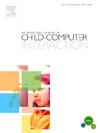Age-related effects of coding interventions
Q1 Social Sciences
International Journal of Child-Computer Interaction
Pub Date : 2025-05-15
DOI:10.1016/j.ijcci.2025.100747
引用次数: 0
Abstract
Past research has shown that children as young as 4–6 years can learn to code through virtual (digital) or plugged (physical, analogic) coding activities, and that exposure to those activities benefits children's cognitive skills too. Indeed, two executive functions (EFs), planning and response inhibition, seem to be strongly associated with coding. However, it remains unclear whether children's cognitive response to virtual coding instruction varies with children's age. Only a few studies to date, mostly focused on older students (aged 10–18 years), have examined age-related differences in response to coding instruction. No such studies as yet have explored whether age differences in learning to code also translate in differential cognitive benefits of coding with children's age. The present study compared the response to an 8-h coding intervention of 273 first graders (5–7 years) and 164 fourth graders (8–10 years), examining whether their respective gains in coding abilities, planning (Tower of London test), and response inhibition (Stroop test and NEPSY-II square/circle test) differed following exposure to coding. Multilevel analyses with socio-economic status covariate show significant effects of the intervention on both 1st and 4th graders' coding skills and across all cognitive measures (planning accuracy, response inhibition accuracy and time). For coding accuracy, both first and fourth graders improved, with large effect sizes (d = −1.53 for first graders, d = −1.84 for fourth graders). The experimental groups showed greater post-test gains in planning accuracy in both grades (d = −1.44 for first graders, d = −0.91 for fourth graders). First graders decreased inhibition errors significantly after the intervention in both NEPSY-II and Stroop tasks (respectively, t(425) = 8.21, p < 0.001, d = 0.80; t(425) = 11.37, p < 0.001, d = 1.10), as well as the fourth graders (t(427) = 3.79, p < 0.001, d = 0.38 in NEPSY-II, t(427) = 4.56, p < 0.001, d = 0.44 in Stroop).
These findings suggest that coding interventions designed with age-appropriate complexity can support not only the development of coding abilities but also enhance EFs skills across different age levels. The intervention's strong impact on younger children suggests that structured coding interventions should be introduced early as a fundamental component of childhood education.
编码干预的年龄相关效应
过去的研究表明,4-6岁的儿童就可以通过虚拟(数字)或插入(物理、类比)编码活动来学习编程,接触这些活动也有益于儿童的认知技能。事实上,两个执行功能(EFs),计划和反应抑制,似乎与编码密切相关。然而,目前尚不清楚儿童对虚拟编码教学的认知反应是否随年龄的变化而变化。迄今为止,只有少数研究(主要针对年龄较大的学生(10-18岁))研究了与年龄相关的编码教学反应差异。目前还没有这样的研究探讨学习编码的年龄差异是否也会转化为儿童年龄编码的不同认知益处。本研究比较了273名一年级学生(5-7岁)和164名四年级学生(8-10岁)对8小时编码干预的反应,考察了他们在编码能力、计划(伦敦塔测试)和反应抑制(Stroop测试和nepsyi - ii方/圆测试)方面的各自增益是否在编码暴露后有所不同。社会经济地位协变量的多水平分析显示,干预对一年级和四年级学生的编码技能和所有认知测量(计划准确性、反应抑制准确性和时间)都有显著影响。在编码准确性方面,一年级和四年级学生均有提高,且效应量较大(一年级的d = - 1.53,四年级的d = - 1.84)。实验组在两个年级的计划准确性测试后都有较大的提高(一年级的d = - 1.44,四年级的d = - 0.91)。干预后,一年级学生在NEPSY-II和Stroop任务上的抑制错误显著减少(t(425) = 8.21, p <;0.001, d = 0.80;T (425) = 11.37, p <;0.001, d = 1.10),四年级学生(t(427) = 3.79, p <;0.001,在NEPSY-II d = 0.38, t (427) = 4.56, p & lt;0.001,在Stroop中d = 0.44)。这些研究结果表明,具有与年龄相适应的复杂性的编码干预不仅可以支持编码能力的发展,还可以提高不同年龄层次的EFs技能。干预措施对年幼儿童的强烈影响表明,应尽早引入结构化编码干预措施,作为儿童教育的基本组成部分。
本文章由计算机程序翻译,如有差异,请以英文原文为准。
求助全文
约1分钟内获得全文
求助全文
来源期刊

International Journal of Child-Computer Interaction
Social Sciences-Education
CiteScore
7.20
自引率
0.00%
发文量
73
 求助内容:
求助内容: 应助结果提醒方式:
应助结果提醒方式:


